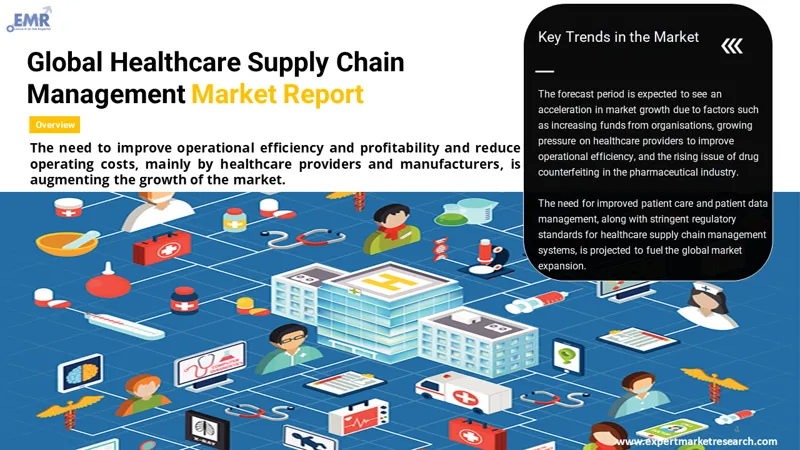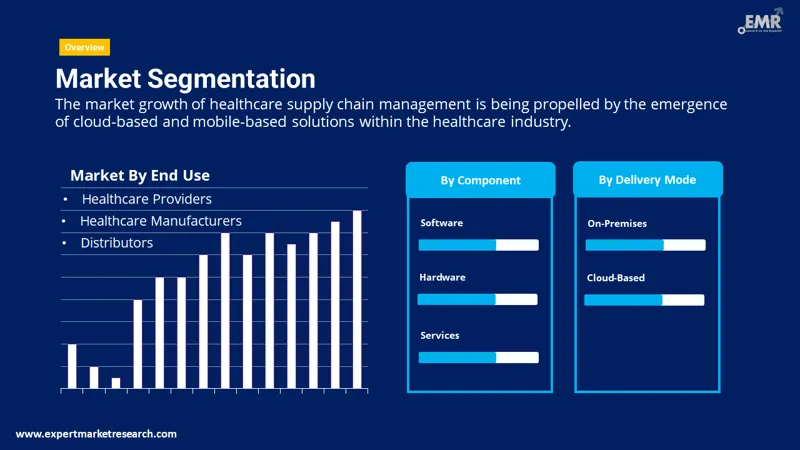
Consumer Insights
Uncover trends and behaviors shaping consumer choices today
Procurement Insights
Optimize your sourcing strategy with key market data
Industry Stats
Stay ahead with the latest trends and market analysis.
The healthcare supply chain management market reached a value of about USD 2.99 Billion in 2025. The market is further expected to grow at a CAGR of about 7.80% in the forecast period of 2026-2035 to reach a value of around USD 6.34 Billion by 2035 owing to the emergence of cloud-based solutions.
Base Year
Historical Period
Forecast Period
Compound Annual Growth Rate
7.8%
Value in USD Billion
2026-2035
*this image is indicative*
Due to the increasing number of unique device identification initiatives and improved healthcare infrastructure, North America is expected to dominate the healthcare supply chain management market during the forecast period. This large share can also be attributed to factors such as the consolidation of hospitals, large manufacturing hubs, the rising prevalence of chronic diseases, and growing awareness in the region. Constantly developing healthcare and IT infrastructure and rising demand for cloud computing contribute significantly to the market growth. The United States is the largest market for healthcare technologies as several companies in the country provide healthcare technology services. Due to the well-established healthcare system, the United States is expected to have the largest market share. The rising adoption of scanning technologies such as barcodes and RFID by manufacturers to curb counterfeit drugs is also aiding the market growth in the region.

Read more about this report - REQUEST FREE SAMPLE COPY IN PDF
Asia Pacific is expected to grow at the highest growth rate in the forecast period of 2023 to 2027 due to the availability of mobile-based healthcare solutions and technological advancements in countries such as India, China, and Japan. The rising number of government initiatives to inspire healthcare providers and other healthcare organisations to adopt cloud-based software solutions to improve inventory management systems is also expected to propel the healthcare supply chain management market in the Asia Pacific region over the forecast years.

Read more about this report - REQUEST FREE SAMPLE COPY IN PDF
Supply chain management (SCM) is a critical part of the healthcare business that necessitates strategic material management and distribution systems to reduce costs and increase efficiency in providing quality patient care. In the healthcare industry, supply chain systems assure the timely delivery of medical goods such as medications, surgical kits, and medical devices.
Market Breakup by Component
Market Breakup by Delivery Mode
Market Breakup by End Use
Market Breakup by Region
The emergence of cloud-based and mobile-based solutions across the healthcare industry is propelling the market growth of healthcare supply chain management. Increasing funds from organisations, rising pressure on healthcare providers to enhance operational efficiency, growing drug counterfeiting in the pharmaceutical industry, rapid increase in the adoption of GS1 standards and unique device identification (UDI) for medical devices are some of the factors expected to accelerate the growth of the market in the forecast period. Further, increasing the need to improve operational efficiency and profitability and reduce operating costs, mainly by healthcare providers and manufacturers, is augmenting the growth of the target market. Other important factors driving the global market growth include a growing emphasis on automation of healthcare processes and the increased adoption of cutting-edge technologies such as AI, Big Data, Blockchain, and the Internet of Things (IoT). Additionally, the increased need for improved patient care, patient data management, and stringent regulatory standards for healthcare supply chain management systems are projected to fuel global market expansion.
The report gives a detailed analysis of the following key players in the global healthcare supply chain management market, covering their competitive landscape, capacity, and latest developments like mergers, acquisitions, and investments, expansions of capacity, and plant turnarounds:
The comprehensive EMR report provides an in-depth assessment of the market based on the Porter's five forces model along with giving a SWOT analysis.




*While we strive to always give you current and accurate information, the numbers depicted on the website are indicative and may differ from the actual numbers in the main report. At Expert Market Research, we aim to bring you the latest insights and trends in the market. Using our analyses and forecasts, stakeholders can understand the market dynamics, navigate challenges, and capitalize on opportunities to make data-driven strategic decisions.*
Get in touch with us for a customized solution tailored to your unique requirements and save upto 35%!
In 2025, the global market for healthcare supply chain management attained a value of nearly USD 2.99 Billion.
The market is projected to grow at a CAGR of 7.80% between 2026 and 2035.
The market is estimated to witness healthy growth in the forecast period of 2026-2035 to reach USD 6.34 Billion by 2035.
The major drivers of the market include the increasing funds from organisations, rising pressure on healthcare providers to enhance operational efficiency, increasing drug counterfeiting in the pharmaceutical industry, increasing the need to enhance operational efficiency and profitability and reduce operating costs, and growing emphasis on automation of healthcare processes, increased need for improved patient care, improved patient data management, and stringent regulatory standards.
The emergence of cloud-based, as well as mobile-based solutions across the healthcare sector and the rapid rise in the adoption of GS1 standards and unique device identification (UDI) for medical devices are the key industry trends propelling the market growth.
The major regions in the industry are North America, Latin America, the Middle East and Africa, Europe, and the Asia Pacific.
The several components in the market are software, hardware, and services.
Based on delivery mode, the market is divided into on-premises and cloud-based.
The end-uses of the market are healthcare providers, healthcare manufacturers, and distributors, among others.
The major players in the industry are Jump Technologies, Inc., Infor, Vizient Inc., Tecsys Inc., and McKesson Medical-Surgical, among others.
Explore our key highlights of the report and gain a concise overview of key findings, trends, and actionable insights that will empower your strategic decisions.
| REPORT FEATURES | DETAILS |
| Base Year | 2025 |
| Historical Period | 2019-2025 |
| Forecast Period | 2026-2035 |
| Scope of the Report |
Historical and Forecast Trends, Industry Drivers and Constraints, Historical and Forecast Market Analysis by Segment:
|
| Breakup by Component |
|
| Breakup by Delivery Mode |
|
| Breakup by End Use |
|
| Breakup by Region |
|
| Market Dynamics |
|
| Supplier Landscape |
|
| Companies Covered |
|
Datasheet
One User
USD 3,299
USD 2,969
tax inclusive*
Single User License
One User
USD 5,499
USD 4,949
tax inclusive*
Five User License
Five User
USD 6,999
USD 5,949
tax inclusive*
Corporate License
Unlimited Users
USD 8,199
USD 6,969
tax inclusive*
*Please note that the prices mentioned below are starting prices for each bundle type. Kindly contact our team for further details.*
Flash Bundle
Small Business Bundle
Growth Bundle
Enterprise Bundle
*Please note that the prices mentioned below are starting prices for each bundle type. Kindly contact our team for further details.*
Flash Bundle
Number of Reports: 3
20%
tax inclusive*
Small Business Bundle
Number of Reports: 5
25%
tax inclusive*
Growth Bundle
Number of Reports: 8
30%
tax inclusive*
Enterprise Bundle
Number of Reports: 10
35%
tax inclusive*
How To Order

Select License Type
Choose the right license for your needs and access rights.

Click on ‘Buy Now’
Add the report to your cart with one click and proceed to register.

Select Mode of Payment
Choose a payment option for a secure checkout. You will be redirected accordingly.
Gain insights to stay ahead and seize opportunities.

Get insights & trends for a competitive edge.

Track prices with detailed trend reports.

Analyse trade data for supply chain insights.

Leverage cost reports for smart savings

Enhance supply chain with partnerships.

Connect For More Information
Our expert team of analysts will offer full support and resolve any queries regarding the report, before and after the purchase.
Our expert team of analysts will offer full support and resolve any queries regarding the report, before and after the purchase.
We employ meticulous research methods, blending advanced analytics and expert insights to deliver accurate, actionable industry intelligence, staying ahead of competitors.
Our skilled analysts offer unparalleled competitive advantage with detailed insights on current and emerging markets, ensuring your strategic edge.
We offer an in-depth yet simplified presentation of industry insights and analysis to meet your specific requirements effectively.
Share